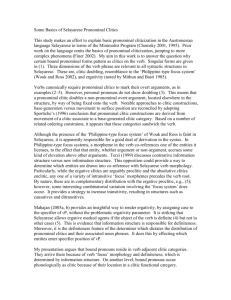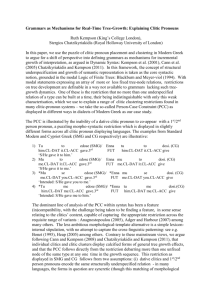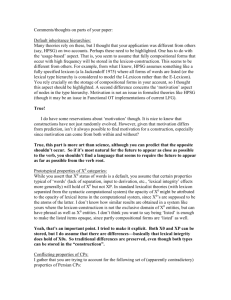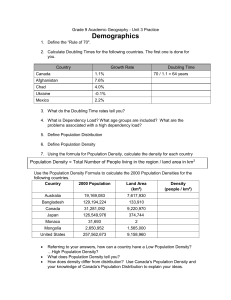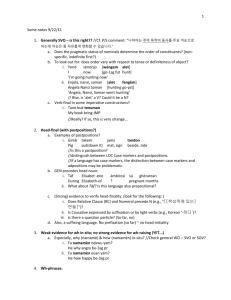Object reduplication in Maltese
advertisement
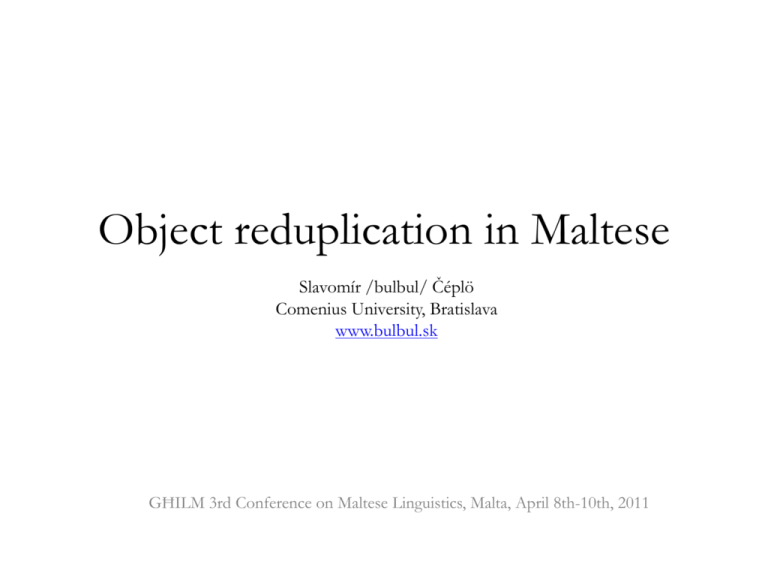
Object reduplication in Maltese
Slavomír /bulbul/ Čéplö
Comenius University, Bratislava
www.bulbul.sk
GĦILM 3rd Conference on Maltese Linguistics, Malta, April 8th-10th, 2011
Introduction
Object reduplication (OR):
“A syntactic phenomenon where the lexical object co-occurs with a
co-referential pronominal clitic.”
[1]
@grimcris
azi
l'ami
vazut
pe
fanuli
tau
Grim
to.NAME
today
CL.ACC=have.1SG
see=PART
ACC
fan=DET
your
NAME
“@grimcris, I saw your fan today :))”
http://twitter.com/Sixx_/status/10823172549, retrieved on December 23rd, 2010.
≈ Clitic doubling
Clitics:
{-ni, -k, -h/-u, -ha, -na, -kom, -hom}
{-li, -lek, -lu, -lha, -lna, -lkom, -lhom}
Introduction
Object reduplication
Balkan Sprachbund: Miklosich 1869
Romance languages outside of Balkans: Jaeggli 1982
Berber: Guerrsel 1995
Arabic: Aoun 1999
Maltese:
-Sutcliffe 1939 (“The direct suffixes are often used redundantly, but effectively.”)
-Fabri 1993
-Fabri & Borg 2002, Borg & Alexander-Azzopardi 2009
Object reduplication
Traditional view: One unitary phenomenon
Recent reanalysis (Dimitrova-Vulchanova and Vulchanov 2008; Krapova and Cinque 2008; Tsakali and
Anagnostopoulou 2008):
Clitic doubling
(Object reduplication)
Clitic doubling proper (CD)
Clitic Left Dislocation (CLLD)
Hanging Topic Construction (HTC)
Clitic Right Dislocation (CLRD)
Focus Fronting (FF)
Clitic Doubling proper (CD) and the rest
Common features of all OR phenomena:
-Co-occurrence of lexical object with clitic
-Scope (specificity/definiteness)
-Pragmatics (in languages where some types of OR are not obligatory)
Differences:
-Position within sentence
Clitic Doubling proper (CD) vs. the rest
“True” clitic doubling (CD) applies to the cases when the
full NP occurs in its argument position inside the clause.”
(Dimitrova-Vulchanova & Vulchanov 2008:107)
In Maltese:
- Argument position: SVO
- Inside the clause vs. clause periphery
Clitic Doubling proper (CD) vs. the rest
Inside the clause [1] vs. clause periphery [2]
[1]
fejn
iridu
jafu
juzawha
l bibja
where
3.IMPF=want=3PL
3.IMPF=know=3PL
3.IMPF=use=3PL=CL.ACC.3SG.F
DEF Bible
“They know how to use the Bible
biex
jiggustifikaw
id dhul
tal
klandestini
to
.IMPF=justify=3PL
DEF entry
GEN=DEF
illegal=PL
to justify the entry of illegals wherever they want.”
http://www.vivamalta.org/forum/archive/index.php/t-3812.html
[2]
Il-vettura
raha
ukoll
il-kunsillier
Francis Callus...
DEF=car
see.3PF=CL.ACC.3SG.F
too
DEF=councilor
NAME
“Councilor Francis Callus also saw the vehicle...”
Object reduplication
Object
reduplication
Clitic doubling proper (CD)
Clitic Left Dislocation (CLLD)
Hanging Topic Construction (HTC)
Clitic Right Dislocation (CLRD)
Focus Fronting (FF)
Clitic Left Dislocation (CLLD)
Direct object:
[1]
Il-vettura
raha
ukoll
il-kunsillier
Francis Callus...
DEF=car
see.3PF=CL.ACC.3SG.F
too
DEF=councilor
NAME
“Councilor Francis Callus also saw the vehicle...”
Indirect object:
[2]
Lit-tfal
trid
tixtrilhom
rigal
DAT=DEF-children
2SG.IMPF=want
2SG.IMPF=buy=CL.DAT.3PL
gift
“You might want to buy a gift for the kids.”
ittorca-8854.html-cleaned.txt
Borg & Azzopardi-Alexander (2009:75): left dislocation / topicalization of indirect objects and is
incompatible with the IO marker, but see [2].
Clitic Left Dislocation (CLLD)
Traditionally defined scope of CLLD in Maltese:
1.Definite NPs (incl. inherently definite NPs like names and pronouns)
“… in fact, pronominal clitics can only be co-referential with definite NPs.”
(Fabri & Borg 2002:360)
Actual scope:
1.Definite NPs (incl. inherently definite NPs like names and pronouns)
2.Some quantified NPs (kull, xi)
3.Bare nouns
Clitic Left Dislocation (CLLD)
Quantified NPs - direct objects
[3]
Kull
sold
investejnieh
fihom...
every
coin
invest=1SG.PL.PERF=ACC.CL.3SG.M
in=3SG.PL
“We invested in them every penny…”
ittorca-10667.html-cleaned.txt
[4]
Lil
xi
whud
minnhom
Pablo
kien
DO
some
ones
from=3PL
name
AUX.PERF.3SG.M
“Some of them, Pablo
jafhom
tajjeb...
3SG.IMPF=know=ACC.CL.3PL
well
knew them well …
ittorca-2379.html-cleaned.txt
Clitic Left Dislocation (CLLD)
Quantified NPs - indirect objects
[4]
Lil
kull
sindku
fl-Amerika
bagħtitilhom
tazza
żgħira …
DAT
every
mayor
in=DEFAmerica
send=1SG.PERF=DAT.CL.3SG
glass
small=F
“To every mayor in America, I sent them a small glass…”
Niċċa tipika hija waħda ta' San Nikola li kien hemm fi Triq is-Santwarju f'Ħaż-Żabbar u li ma nafx x'sar minnha!
[5]
Lil
xi
niċeċ
oħra
insterqulhom
DAT
some
statue.PL
other.PL
3.IMPF=PASS=steal=3PL=DAT.CL.3PL
“For some statues, they stole
il-fanali
li
kellhom
quddiemhom …
DEF=lantern=PL
REL
have.PERF=3PL
in front of=3PL
the lanterns they had in front of them …”
ittorca-9967.html-cleaned.txt
Clitic Left Dislocation (CLLD)
Bare nouns – direct objects
[5]
Ħaxix
bħal
bell peppers, zucchini u karrotti
vegetables
such as
bell peppers
zucchini and carrots
“Vegetables such as bell peppers, zucchini and carrots, you can
tgħallih
jekk
2SG.IMPF=boil=ACC.CL.3SG.M
if
boil them if you like food prepared that way.”
tħobb
2SG.IMPF=like
l-ikel
DEF-food
tista
2SG.IMPF=can
msajjar sew.
cooked thus
maltarightnow-48-12231.html-cleaned.txt
Bare nouns – indirect objects
Fil-Kenja hija haga normali li bniedem jiekol gurnata iva u gurnata le.
[6]
Bniedem toffrilu
l-ikel
person
2SG.IMPF=offer=DAT.CL.3SG.M DEF=food
“A person, you offer him food and he tells you
Imma
jien
il-bierah
kilt!
but
I
yesterday
eat=PERF.1SG
‘But I ate yesterday!’”
lorizzont-20720.html-cleaned.txt
u jghidlek,
and 3.IMPF=say=DAT.CL.2SG.M
Clitic Left Dislocation (CLLD)
Bare nouns
Indefiniteness vs. topichood?
De Cat 2010:
1.Existential indefinite (“a specific item from the set of all X”)
2.Generic indefinite (“a typical X embodying all properties of X / representing all X”)
“If a specific reading is forced (by using a past tense ), this sentence is no
longer acceptable ...”
(De Cat 2010:21)
=> quantified NPs with kull
Hanging Topic Construction
Primary contrast to CLLD:
Level of connectivity with the rest of the clause
“…topicalised expressions are in a looser relationship with the rest
of the sentence…”
(Borg and Azzopardi 2009:75-76)
Sutcliffe 1935: nominativus pendens
Clitic Left Dislocation vs. Hanging Topic
Feature
CLLD
HTC
1.
Category neutral
any
NP only
2.
Iterative
+
-
3.
Non-root contexts
+
-
4.
Free ordering of dislocates
+
-
5.
Obligatory resumptive
clitic only
any
6.
Ordering with respect to wh-
C-CLLD-wh
C-HTC-wh
7.
Connectedness
+
-
8.
Intonational break
weak
strong
Adapted from Villalba 2000:81
Clitic Left Dislocation vs. Hanging Topic
Feature
CLLD
HTC
1.
Category neutral
any
NP only
2.
Iterative
+
-
3.
Non-root contexts
+
-
4.
Free ordering of dislocates
+
-
5.
Obligatory resumptive
clitic only
any
6.
Ordering with respect to wh-
C-CLLD-wh
C-HC-wh
7.
Connectedness
+
-
8.
Intonational break
weak
strong
Clitic Left Dislocation vs. Hanging Topic
Iterative
CLLD
HTC
+
-
HTC: one per sentence
CLLD: several possible
[1]
Jien il-golf ma nafx
x’jarawlu…
I
what=3.IMPF=see=PL=DAT.CL.3SG.M
DEF-golf
NEG
1SG.IMPF=know=NEG
“I don’t know what they see in golf…”
lorizzont-21669.html-cleaned.txt
Clitic Left Dislocation vs. Hanging Topic
Non-root contexts
CLLD
HTC
+
-
“HTLD (=HTC) can be found only in root contexts … CLLD appears in both root
and non-root contexts”
(Krapova and Cinque 2005:259)
[2]
... jien
naħseb
li
finalment din ir-responsabblità
trid
I
1SG.IMPF=think
that
in the end
3SG.F.IMPF=want
this.F DEF-responsibility
“… I think that in the end, the leadership of the Nationalist Party
iġġorrha
wkoll
it-tmexxija
tal-Partit
Nazzjonalista.
3SG.IMPF=carry=ACC.CL.3SG.F
also
DEF-leadership
POSS=DEF-party
nationalist=F
will want to shoulder this responsibility as well.”
illum-2008-01-20_t3.html.txt
Clitic Left Dislocation vs. Hanging Topic
Connectedness
CLLD
+
HTC
-
Case connectivity:
DO / animacy marker “lil” and IO marker “lil” are optional in topicalized / leftdislocated NPs
(Borg and Azzopardi 1997:124, Borg and Azzopardi-Alexander 2009:73-74)
[3]
Jien
lili
qatt
ma
tarani
I
ACC=I
never
NEG 2SG.IMPF=see=ACC.CL.1SG
“I, me, you never will see me on the stage.”
Jien
qatt
ma
I
never
NEG
“I, you never will see me exit — ”
illum-2009-06-14_interview.html.txt
tarani
2SG.IMPF=see=ACC.CL.1SG
fuq
on
il-palk.
DEF-stage
noħroġ —
1.IMPF=exit
CLLD vs. HTC in Maltese
Feature
CLLD
HTC
1.
Category neutral
any
NP only
2.
Iterative
+
-
3.
Non-root contexts
+
-
4.
Free ordering of dislocates
+
-
5.
Obligatory resumptive
clitic only
any
6.
Ordering with respect to wh-
C-CLLD-wh
C-HC-wh
7.
Connectedness
+
-
8.
Intonational break
weak
strong
Focus fronting or topicalization?
Object reduplication is obligatory with left-dislocated topicalized object
(Borg and Azzopardi 1997:124, 126)
Darba sibt ruħi fin-nofs. Kienet ġejja l-elezzjoni ta’ l-1992. Konferenza Stampa tal-Prim Ministru Fenech Adami, l-aħħar waħda fis-sensiela. Kont qed naraha ddar ma’ marti. Min deher għall-Orizzont jew għat-Torċa staqsa waħda dwar id-djar daqsxejn below the belt. It-tweġiba kienet qawwija: “Hawn xi ħadd f’dan ilpajjiż li jiddubita mill-onestà ta’ Joe Cassar?” .L-għada sħabi qaluli:
[1]
“Lilek
biss
ACC=2SG.
only
“He’s only defending you.”
iddefenda.”
3SG.IMPF=defend
illum-2008-02-24_t14.html.txt
Rajtu kemm hi tajba Marlene tagħna.
[2]
Lilha
ħa
ACC=3SG.F take.PERF.3SG.M
“The president took her with him.”
illum-2009-08-30_t14.html.txt
miegħu
l-President.
with=3SG.M
DEF=president
Focus fronting or topicalization?
Fabri & Borg 2002:360
OVS/OSV without cliticization = focus on object (focus
fronting)
Darba sibt ruħi fin-nofs. Kienet ġejja l-elezzjoni ta’ l-1992. Konferenza Stampa tal-Prim Ministru Fenech Adami, l-aħħar waħda fis-sensiela. Kont qed naraha d-dar ma’
marti. Min deher għall-Orizzont jew għat-Torċa staqsa waħda dwar id-djar daqsxejn below the belt. It-tweġiba kienet qawwija: “Hawn xi ħadd f’dan il-pajjiż li jiddubita
mill-onestà ta’ Joe Cassar?” .L-għada sħabi qaluli:
[1]
“Lilek
biss
iddefenda.”
FOCUS = new information introduced
Rajtu kemm hi tajba Marlene tagħna.
[2]
Lilha
ħa
miegħu l-President.
TOPIC = tying the utterance to the rest of the discourse
Focus fronting or topicalization?
Qed issir hafna hidma tajba minn niesi li jibqghu fid-dell,
u jahdmu minghajr ma jidhru. Lilhomi irridu
naghtuhomi kull gieh.
VS
Niftakar li kien kellimni l-president Michael Buttiġieġ u
offrieli li nibda nitħarreġ b’xejn fuq l-isnuker tal-każini (IlKażin Laburista tal-Mellieħa). Lilhomi irrid ngħid# grazzi kbira.
Lilkom il-mexxejja u għalliema tal-Kulleġġ irrid ngħidilkom grazzi.
...huma l-ħin kollu qegħdin jaħdmu fil-komunitajiet jirrappreżentaw lill-partit. Irrid
ngħidilhom grazzi tax-xogħol importanti...
Clitic Right Doubling / HTC / Afterthought?
[1]
On
ne
one
NEG
‘We don’t invite louts.’
De Cat 2010:99
lesi
them
invite
invites
pas,
not
les
the
malotrusi.
louts
1. Right dislocation of NPs with/without Case Connectivity
[2]
Jien
nieklok
lilek.
I
1.IMPF=eat=CL.ACC.2SG
ACC=2SG
“I will eat you.”
maltarightnow-39-99819261.html-cleaned.txt
[3]
Hekk
grali
jien.
thus
happen.PERF.3SG=CL.DAT.2SG.M
you
“This is what happened to me.”
lorizzont-17259.html-cleaned.txt
Tinstema' semplici u hekk hi, jidhirlii jieni.
Il-qarrejja tat-TORĊA saru jagħrfuha mill-ewwel u jwaqqfuha biex jifirħulhai hi i u
għaddejja fit-triq.
Clitic Right Doubling / HTC / Afterthought?
2. Information structure
[5]
U
mort
ghand
il-Kumissarju
u
ha
nghid
and
go=PERF.1SG
to
DEF=commissioner
and
FUT
1SG.IMPF=say
And I went to the Commissioner and I will tell you
x’ghidtlu
lill-Kummissarju u
jikkonfermah
hu.
what=say=1SG.PERF=CL.DAT.3SG.M
DAT=DEFcommissioner
3.IMPF=confirm=CL.
ACC.3SG.M
he
and
what I told him, the Commissioner, and he confirms it himself.
http://archive.maltatoday.com.mt/2009/03/08/sbalzan.html
Dislocated element provides additional information => afterthought
3. Intonational break
[6]
Min
jaghtihomlha,
wara
kollox, dawn
ic-cifri
lill-Unjoni Ewropea?
who
3.IMPF=give=CL.ACC.3P
L=CL.DAT.3SG.F
after
all
DEF=number
=PL
DAT=DEF-EU
these
“Who gives them to them, after all, these numbers, to the EU?”
www.torca.com.mt/news2.asp?artid=5474
Conclusion
- More study of both OR and the syntax of the sentence periphery is required.
- For Balkan linguistics: both CLLD and CD proper possible with bare nouns.
- For Arabic dialectology: both CLLD and CD possible in Maltese as opposed to
most varieties of Arabic with CLLD only.
Bibliography
1. Aoun, Joseph. 1999. “Clitic-doubled Arguments”. Beyond Principles and Parameters: Essays in Memory of Osvaldo Jaeggli, ed. by Osvaldo Jaeggli,
Kyle Johnson & Ian G. Roberts, 13-42. Dordrecht: Kluwer Academic Publishers.
2. Aoun, Joseph E., Benmamoun, Elias & Choueiri, Lina. 2010. The Syntax of Arabic. Cambridge: CUP.
3. Borg, Albert & Marie Azzopardi-Alexander. 2009. “Topicalisation in Maltese”. Introducing Maltese Linguistics, ed. by Bernard Comrie et al.,
71-81. Amsterdam: John Benjamins.
4. Borg, Albert & Marie Azzopardi-Alexander. 1997. Maltese. Lingua descriptive grammars. London: Routledge.
5. De Cat, Cécile. 2010. French Dislocation. Interpretation, Syntax, Acquisition. Oxford: OUP.
6. Dimitrova-Vulchanova, Mira & Vulchanov, Valentin. 2008. “Clitic doubling and Old Bulgarian”. Clitic Doubling in the Balkan Languages, ed.
by Dalina Kalluli and Liliane Tasmowski, 105-132. Amsterdam: John Benjamins.
7. Fabri, Ray. 1993. Kongruenz und die Grammatik des Maltesischen. Tübingen: Max Niemeyer Verlag.
8. Fabri, Ray & Albert Borg. 2002. “Topic, focus and word order in Maltese”. Aspects of the Dialects of Arabic Today, ed. by Abderrahim
Youssi, Fouzia Benjelloun, Mohamed Dahbi & Zakia Iraqui-Sinaceur, 354–363. Rabat: Amapatril.
9. Franks, Steven & King, Tracy Holloway. 2000. A Handbook of Slavic Clitics. New York: OUP.
10. Friedman, Victor A. 2008. “Balkan object reduplication in areal and dialectological perspective”. Clitic Doubling in the Balkan Languages, ed.
by Dalina Kalluli and Liliane Tasmowski, 35-63. Amsterdam: John Benjamins.
11. Holton, David & Mackridge, Peter & Philippaki-Warburton, Irene. 1997. Greek: A Comprehensive Grammar of the Modern Language. London:
Routledge.
12. Kalluli, Dalina & Tasmowski, Liliane. 2008. “Clitic doubling, core syntax and the interfaces”. Clitic Doubling in the Balkan Languages, ed. by
Dalina Kalluli and Liliane Tasmowski, 1-32. Amsterdam: John Benjamins.
13. Krapova, Iliyana & Cinque, Guglielmo. 2008. “Clitic reduplication constructions in Bulgarian”. Clitic Doubling in the Balkan Languages, ed. by
Dalina Kalluli and Liliane Tasmowski, 257-287. Amsterdam: John Benjamins.
14. López, Luis. 2009. A Derivational Syntax for Information Structure. New York: OUP.
15. Sutcliffe, Edmund. 1936. A Grammar of the Maltese Language with Chrestomathy and Vocabulary. Oxford: OUP.
16. Sobolev, Andrej N. 2004. “On the areal distribution of syntactic properties in the languages
17. of the Balkans”. Balkan Syntax and Semantics, ed. by Olga Mišeska Tomić, 61-100. Amsterdam: John Benjamins.
18. Tsakali, Vina & Anagnostopoulou, Elena. 2008. “Rethinking the Clitic Doubling parameter”. Clitic Doubling in the Balkan Languages, ed. by
Dalina Kalluli and Liliane Tasmowski, 322-357. Amsterdam: John Benjamins.
19. Villalba, Xavier. 2000. The Syntax of Sentence Periphery. Barcelona: Universitat autònoma de Barcelona (unpublished PhD dissertation).
20. Zagona, Karen: 2003. The Syntax of Spanish. Cambridge: CUP.
